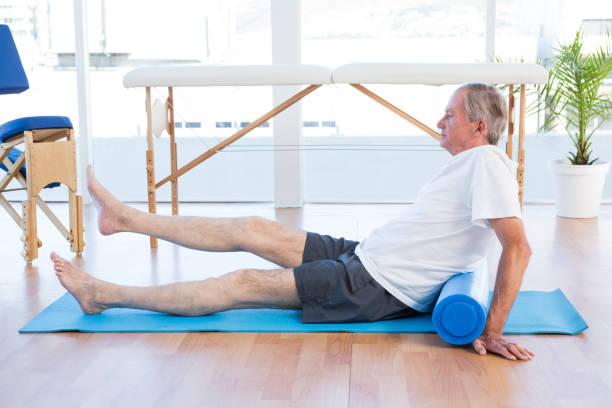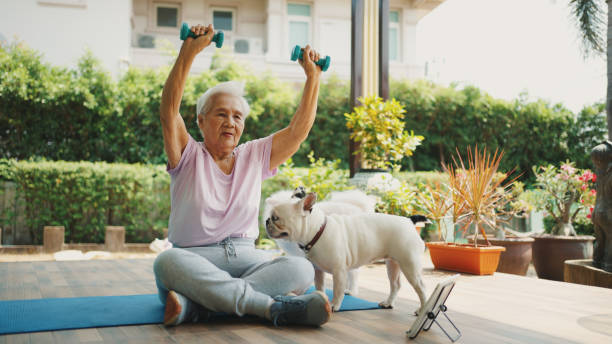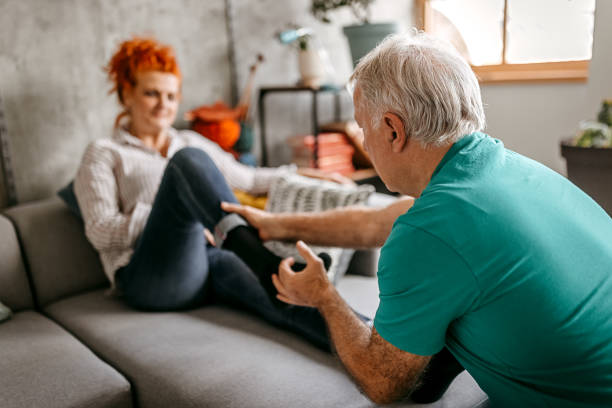Introduction

Exercising is essential to maintaining good health, but it can be particularly challenging for those with mobility restrictions due to Parkinson's disease. Adapting exercise routines to suit individuals living with this condition requires special consideration.
This blog post will talk about how modifying exercise routines can enhance the life quality of people who have Parkinson's disease. It will also discuss techniques for creating and executing exercise routines that meet their specific requirements. Through this discussion, readers will be equipped with the knowledge to create customized exercise programs that meet the specific needs of those with mobility restrictions due to Parkinson's disease.
How does exercise help with Parkinson's Disease?
Exercise can help address some motor symptoms associated with Parkinson's Disease, including tremors and stiffness. Regular physical activity helps to improve muscle strength, flexibility, balance, and coordination. It also increases endurance and boosts energy levels, allowing individuals living with Parkinson's Disease to do the activities they enjoy for longer periods.
When it comes to adapting exercise routines for individuals living with mobility restrictions due to Parkinson's Disease, safety is the number one priority. Choosing exercises that can be done safely and comfortably is important to minimize any discomfort or risk of injury. Exercises should be tailored according to the individual's specific needs and abilities. In general, low-impact activities such as walking, swimming, and cycling are recommended. Strength-training exercises should also be included, focusing on the legs, core, and arms.
It's important to note that exercise may need to be modified over time depending on how Parkinson's disease progresses. Adjustments may be needed to accommodate any mobility or balance changes. Working with a physical therapist is recommended, as they can help design an appropriate exercise program and make necessary adjustments. It's also important to consult a doctor before beginning any exercises, as some medications and conditions may affect the type of activities suitable for an individual with Parkinson's Disease.
Overall, exercise can be important in helping individuals with Parkinson's Disease manage their symptoms and stay physically active. By adapting the exercises to suit individual needs and abilities, it is possible to enjoy a safe and enjoyable workout routine that helps keep mobility restrictions due to Parkinson's Disease at bay.
What exercises should a Parkinson's patient do?
Exercise is essential for individuals living with Parkinson's Disease (PD). It can help to improve physical function, reduce disability and slow the deterioration of movement. However, adapting exercise routines to suit individuals with mobility restrictions due to PD can be challenging. Here are five exercises that may be helpful for those living with PD:
1. Tai Chi

Tai Chi is a traditional Chinese martial art emphasizing slow, controlled movements. This exercise has been found to improve balance and gait in PD patients and reduce falls and freezing episodes. The repetitive motions associated with Tai Chi can help those living with PD to develop better motor control and body awareness. Furthermore, focusing on proper breathing techniques helps reduce stress and improve relaxation. Tai Chi can be modified for those with limited mobility, so it is an accessible form of exercise for individuals living with PD.
2. Resistance Training
Resistance training improves physical function and strength in people living with PD. Low-impact aerobic exercises like light weights or resistance bands are relatively safe for PD patients. Resistance training helps to improve muscular endurance and strength, which can help individuals maintain their mobility and independence for longer. Furthermore, it has been found to reduce fatigue in people living with PD.
3. Yoga

People with PD can benefit from yoga as it improves balance, flexibility, and coordination. Yoga also involves breath work which reduces stress and promotes relaxation. Furthermore, it can even alleviate pain and improve mood in PD patients. Moreover, yoga can be adapted to accommodate individuals with limited mobility, making it a viable exercise option.
4. Aquatic Exercise
Aquatic exercise is a great form of low-impact exercise that is beneficial to people living with PD. The water's natural resistance helps improve muscular strength, endurance, balance, and coordination. Additionally, the buoyancy of the water reduces the risk of falls or injury while exercising. Furthermore, aquatic exercise can be modified to meet individual needs and accommodate those with limited mobility.
5. Walking
People with PD can benefit from regular walking, improving their balance, posture, and gait while reducing stiffness in muscles and joints. Moreover, it can help them maintain physical function, allowing for independence. Walking is an accessible form of exercise for those with limited mobility due to PD, with indoor and outdoor options available.
By incorporating these five exercises into an exercise routine tailored to the individual's needs and abilities, individuals living with PD can benefit greatly from improved physical function and reduced disability. Exercise is an important part of living with PD and should be combined with other therapies, such as medication, speech therapy, and occupational therapy, to maximize overall health and quality of life.
Why is Physical Activity Important for Parkinson's Disease?

Physical activity's importance for individuals with mobility restrictions due to Parkinson's Disease cannot be understated. Regular exercise can help improve balance, coordination, and range of motion, reduce stiffness and tremors, boost energy levels, manage weight control, and even improve mental health. To manage Parkinson's disease and reduce its impact, regular exercise is necessary.
It is important to tailor exercise routines to suit individual needs to get the most benefit from physical activity. People with Parkinson's disease are likely to experience varying mobility restrictions, so adapting exercises accordingly is essential.
Regular physical activity is crucial, regardless of any limitations in mobility. Low-impact activities like walking, cycling, and swimming can improve balance, coordination, and range of motion. People with Parkinson's disease can also benefit from strength training as it strengthens the muscles required for everyday movements.
Exercise routines must be tailored to the individual's needs and abilities. For instance, individuals with more advanced mobility restrictions may need to modify activities or use assistive devices such as walkers or canes. In addition, exercises that focus on a range of motion should be incorporated into routines regularly to keep joints flexible and prevent stiffness.
Overall, physical activity is a vital part of managing the progression of Parkinson's disease. Adapting exercise routines to suit individual needs is essential to benefit most from these activities. By doing so, individuals with mobility restrictions due to Parkinson's Disease can help reduce their symptoms and improve their quality of life.
How does exercise help with Parkinson's Disease?
In the case of Parkinson's Disease (PD), exercise can play a key role in managing symptoms, improving mobility, and reducing pain. Exercise helps to strengthen muscles and joints while improving balance. It also increases flexibility, range of motion, and endurance, which can help individuals living with PD better adapt to their physical limitations. Regular exercise also has mental and emotional health benefits, such as reduced anxiety and depression.
However, when adapting exercise routines for those living with mobility restrictions due to PD, there are certain considerations to bear in mind. Exercises must be tailored specifically for their individual needs and abilities, as different people will have varying physical capability levels depending on the severity of their PD.
For individuals living with PD, it is often best to start with low-impact exercises that focus on a range of motion and flexibility. Examples include gentle stretching, yoga poses, or tai chi movements. When done correctly and consistently over time, these exercises can help improve balance, coordination, and posture and reduce pain and stiffness.
Incorporating strength training exercises into a PD exercise routine is also important. They help build major muscle groups and improve physical abilities such as walking, standing, and climbing stairs Weight-bearing exercises such as squats, lunges, and push-ups can be done while sitting or standing to work the body's larger muscles. Some individuals may need to use assistive devices such as a cane, walker, or wheelchair to complete these exercises safely.
Other forms of aerobic exercise can also benefit those living with PD. Activities like swimming, cycling, and walking can enhance endurance and balance while reducing fatigue. For individuals who have difficulty completing more traditional forms of exercise, aquatic therapy and chair exercises may be the best option.
It is important to remember that everyone's physical abilities will differ depending on the severity of their PD. Therefore, individuals must consult a doctor before beginning any new exercise routine. In addition, it can also help to find an experienced physical therapist or an exercise coach specializing in Parkinson's Disease. With the right guidance and support, those with mobility restrictions due to PD can safely and effectively adapt their exercise routines to suit their needs.
FAQ's
How do you maintain mobility with Parkinson's disease?
Exercise is essential for maintaining mobility and physical function in people with Parkinson's disease (PD). Exercise can help to reduce pain, fatigue, and balance issues and improve strength. However, adapting your exercise routine to suit a person living with PD may be difficult due to the mobility restrictions caused by the condition. Collaborating with a physical therapist or exercise specialist is essential to discover the most suitable exercises for you.
What are the exercise recommendations for Parkinson's patients?
In general, the exercise recommendations for people living with Parkinson's disease include:
-
Engaging in low-impact aerobic activities like walking, swimming, and cycling is recommended.
-
Strength balance training to improve muscle strength and flexibility.
-
Balance intense exercise to maintain coordination and reduce the risk of falls.
-
Performing stretching exercises can help improve your range of motion and decrease stiffness.
What lifestyle modification helps Parkinson's disease?
In addition to exercise, lifestyle modifications can benefit people with Parkinson's disease. Getting adequate rest, eating a healthy diet, avoiding alcohol and smoking, and reducing stress are all important for managing the condition.
What are treatment strategies for Parkinson's disease?
Treatment strategies for Parkinson's disease vary depending on the individual and the severity of their symptoms. In general, a combination of medication, physical therapy, occupational therapy, speech therapy, and lifestyle modifications can help to manage symptoms and improve quality of life.
What treatment strategies are being used in patients with Parkinson's disease?
Several treatment strategies are currently used to help people with Parkinson's disease. These include deep brain stimulation, which utilizes electrical stimulation to reduce tremors and stiffness; drug therapy, which can help improve mobility; physical therapy and exercise, which can improve balance, coordination, strength, and flexibility; occupational therapy, which helps individuals maintain their independence; and speech therapy, which can help improve communication.
What is the role of exercise in the management of Parkinson's disease?
Exercise prescription an important part of managing symptoms of Parkinson's disease. Exercise can help improve mobility, strength, balance, coordination, and flexibility. Additionally, it can reduce fatigue and pain. However, people with PD should always consult a physical therapist or flexibility exercise specialist to ensure their exercises are tailored to their needs and abilities. A tailored exercise program can ensure that each individual gets the most benefit from their exercise routine.
Conclusion
I hope this article has provided some useful information on the role of exercise in managing Parkinson's disease and how individuals can adapt their exercise routines to suit their needs. Exercise is an important part of managing PD, and with the right guidance and support, those living with mobility restrictions due to PD can safely and effectively adapt their exercise routine to improve overall health.

